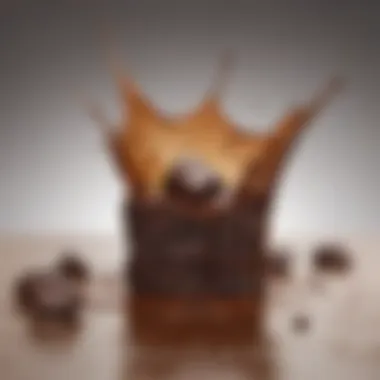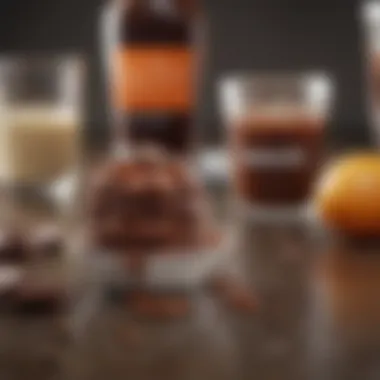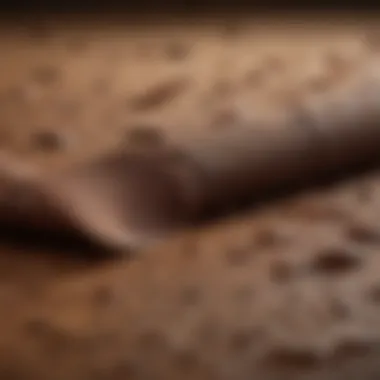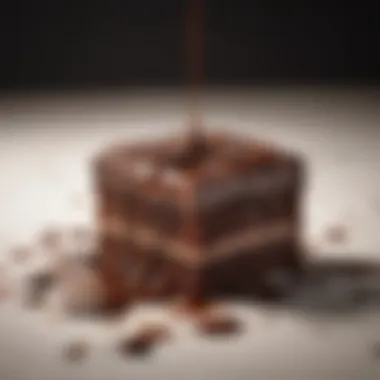Expert Tips for Removing Chocolate Stains from Clothes


Intro
Chocolate stains can be a real pickle, causing distress and frustration for anyone who loves their clothes. Whether it’s a casual mishap during a snack or an indulgent dessert gone awry, these stains can feel like a battle you’re likely to lose. But fret not! This guide aims to equip you with the knowledge you need to tackle these stubborn marks and emerge victorious.
Understanding the nature of chocolate stains is crucial. The composition of chocolate can vary, and so can its impact on different fabrics. Some materials absorb stains more readily than others, which calls for specific approaches tailored to each type. With the right tools and techniques, you can banish these marks effectively. This article focuses on practical steps you can take immediately, pre-treatment methods, and tips that are bound to help along the way.
So, roll up your sleeves and prepare to dive deep into the world of chocolate stain removal, where a few clever tricks and a little perseverance can save your favorite garments.
Understanding Chocolate Stains
When it comes to chocolate stains, the first thing to grasp is what you're really dealing with. Understanding chocolate stains is essential, not just for cleaning but also for preventing further mishaps in the future. Chocolate can be a delightful treat, but once it splatters across your favorite shirt, it can feel like a nightmare. Being armed with the knowledge of how these stains form can be the key to successful removal.
The Composition of Chocolate
To tackle chocolate stains effectively, it's useful to dive into what chocolate actually is. Chocolate is primarily made of cocoa solids, cocoa butter, sugar, and often milk products. Each of these components can contribute to the stubbornness of stains.
- Cocoa Solids: These give chocolate its flavor and dark color. They are also known for their oiliness, which makes them cling to fabrics.
- Cocoa Butter: This is a fat that can leave greasy marks on clothing.
- Sugar: When heated or melted, this can caramelize and form a tough residue.
- Milk Solids: If you’re dealing with milk chocolate, these can add another layer of difficulty, as they might react differently when exposed to heat or detergent.
Each of these ingredients has unique properties that can affect how they interact with different fabrics. For instance, a cotton shirt might absorb a stain differently than a polyester blend. Each fabric reacts uniquely to the elements found in chocolate, which can complicate the cleaning process.
Why Chocolate Stains are Challenging
Chocolate stains are notoriously tricky for several reasons. First off, there’s the combination of sugar and fat. When chocolate heat melts, it can seep deep into the fibers of your clothes, making it harder to treat. Moreover, if you dab at a stain instead of blotting, you risk spreading it further, increasing the clean-up challenge.
- Temperature Sensitivity: Chocolate stains can set quickly if not addressed. Heat can cause the oils to bond with the fabric, making removal difficult.
- Fabric Varieties: Different fabrics absorb stains and react to cleaning methods in varying degrees. Some fabrics, like silk, can react negatively to certain cleaning agents, resulting in further damage.
- Layering of Stains: Sometimes, the chocolate stain might be compounded by other substances — like ice cream on top. This layering makes it complex to address the root of the stain.
"Understanding the components of the stain can help pinpoint effective removal methods, enabling you to tackle problems at their source."
In sum, knowing the composition of chocolate and why it creates such stubborn stains will greatly assist you in choosing the right approach for cleaning and prevention. By acknowledging the issues upfront, you equip yourself with the proper tools to deal with stains before they become permanent blemishes on your garments.
Initial Response to a Chocolate Stain
When it comes to tackling chocolate stains, the adage "a stitch in time saves nine" couldn't ring truer. The first moments after a spill can determine whether that cherished item will become a faded memory or remain part of your wardrobe. Prompt action can significantly lessen the stain's impact, giving you a fighting chance against the stubborn remnants of your last sweet indulgence.
The goal here is not merely to address the immediate issue but to arm oneself with a strategic advantage. By understanding the best practices for quickly responding to a chocolate stain, you can salvage your clothing while also mitigating further damage. Here, we dig into two crucial aspects of this initial response: the importance of timing and the materials you'll need on hand for an effective removal effort.
Acting Quickly: Timing is Key
The moment chocolate hits your fabric, it starts its little dance of mischief. Ignoring it or waiting too long can exacerbate the problem as the oil and sugar in chocolate begin to set into the fibers. It's akin to watching paint dry—delaying the inevitable will only create a more stubborn stain.
Experts suggest addressing the stain as soon as you discover it. For instance, if you find yourself with chocolate on your favorite shirt during a party, take a break and head to the nearest sink.
The quicker you can respond:
- Stains that set less: The longer the chocolate sits, the more porous the fabric becomes to the stain.
- Easier treatment applications: Fresh stains can often be dealt with simpler methods than those that have set in.
- Less chance of spreading: Rubbing it in, without proper treatment, can spread the stain, making the issue larger than it started.
Gathering Necessary Materials
Preparation paves the way for success. Before diving into stain removal, it pays to gather the right tools. This way, when you come upon a chocolate mishap, you're equipped like a knight in shining armor – ready for battle.


Here's a checklist to consider:
- Cold Water: Room temperature or colder water helps prevent the stain from setting. Hot water could inadvertently cook the chocolate onto the fabric.
- Soft Cloth or Paper Towel: Use a clean, white cloth to gently blot the stain. Avoid scrubbing aggressively, as this can push the chocolate deeper.
- Mild Detergent: You don’t need industrial-strength cleaning agents at this stage; a gentle detergent designed for your specific fabric will do.
- Stain Remover: If you have a pre-treatment stain remover at hand, it can be a lifesaver when dealing with chocolate.
- Bucket: When dealing with larger garments, consider using a bucket to soak the fabric in cold water.
By gathering these materials ahead of time, when the chocolate stains appear, you won't find yourself racing against the clock to find supplies—essentially, you're setting yourself up for a smoother stain removal process.
"An ounce of prevention is worth a pound of cure."
In wrapping up this introductory phase, it’s clear that your immediate response can create a ripple effect in the magnitude of your success. The next section will explore how to directly treat the stain, ensuring that your quick response translates into lasting results.
Spot Treatment Techniques
Spot treatment is a critical first line of defense when dealing with chocolate stains. Addressing these stains right after they occur can determine whether the fabric remains wearable or becomes a permanent casualty of a sweet indulgence. The essence of spot treatment lies in its focused approach, allowing individuals to target the stain directly rather than subjecting the entire garment to an extensive washing process. This not only saves time but also conserves water and reduces wear on the fabrics.
Using Cold Water
Cold water is your best friend in the early stages of stain removal. If you think about it, running into hot water can set the stain, making it far more challenging to eliminate. Cold water keeps the chocolate intact long enough for you to treat it. Begin by placing the stained area under cold running water. Do so from the backside, pushing the stain out rather than deeper into the fiber. This method also dilutes the chocolate, minimizing its grip on the fabric. It’s simple, effective, and uses the natural properties of water to your advantage.
Employing Detergents and Soaps
Using liquid detergent or soap can create a significant impact on chocolate stains. Applying a stain-fighting detergent directly onto the chocolate mark boosts your chances for success. Many opt for a gentle dish soap or laundry detergent to pre-treat before laundering, as these options tend to cut through grease quite effectively. Work it into the fabric gently, allowing it to sit for at least five minutes. Remember, patience is its own virtue. Eventually, wash it out with cold water to avoid any residue that may be left behind.
Utilizing Stain Removers
Stain removers come into play when the usual tactics don’t cut it. As a concentrated solution, these products can effectively break down the components of chocolate stains. Look for a formula that specifically targets grease and stains. Apply the solution directly to the affected area and follow the recommended instructions carefully. Usually, letting it sit for a few minutes helps maximize its potency. Always check if it's safe for the fabric by doing a small patch test in an unobtrusive area first. This step is vital, especially if you're dealing with delicate materials or bright dyes that could react adversely.
"An immediate response to stains not only increases your odds of effective removal but also helps maintain the integrity of the fabric in the long run."
Pre-Treatment Steps Before Washing
Before tossing that chocolate-stained garment into the laundry, taking a moment for pre-treatment steps can save you a whole lot of hassle. This stage is where the magic happens; it can mean the difference between a successful stain removal and a stubborn mark that haunts your favorite shirt. The right approach here not only enhances your chances of completely getting rid of that chocolate but also protects the fabric from potential damage that could occur during washing.
Testing Fabric Compatibility
One of the most crucial pre-treatment actions involves checking if the fabric of your clothing can handle various stain removal methods. Different materials respond uniquely to products like detergents or home remedies. For instance, a delicate silk blouse requires a lighter touch compared to a sturdy cotton t-shirt.
To begin, identify the fabric type by looking at the care label. Here’s a tip: even if it’s labeled as machine-washable, some materials might still react negatively to specific pre-treatment solutions. Once you know your fabric's tolerance, create a small mixture of the cleaning solution you plan to use, then test it on an inconspicuous area of the garment. If you see any discoloration or fabric damage, reconsider your approach.
Key Points to Remember:
- Fabrics can react differently to cleaning agents.
- Always do a spot test to avoid further damage.
- Consider alternative solutions if the fabric seems sensitive, such as using plain water or a gentle soap.
Creating a Pre-Treatment Solution
After affirming your fabric’s compatibility, it's time to whip up a pre-treatment solution that specifically targets chocolate stains. The goal here is to break down the chocolate's oils and sugars before they harden during the washing process.
To concoct an effective pre-treatment mixture, here’s a simple recipe:
- Start with 1 cup of cool water.
- Add a tablespoon of liquid dish soap or a gentle detergent—something without too many active stain removal agents, especially for delicate fabrics.
- Incorporate a teaspoon of white vinegar or lemon juice for added acidic power, which can help to cut through the grease.
- Mix well until the solution is uniform.
Once your solution is ready, apply it directly onto the stained area. Gently dab with a clean cloth or sponge, working from the outside of the stain inwards. This prevents the stain from spreading and ensures that more of the chocolate is lifted away from the fabric.


"Taking the time to pre-treat can save not only the garment but the heartache of a ruined favorite item.”
Remember, using too much of the solution can sometimes backfire, so use it sparingly to avoid over-saturation. After allowing the solution to sit for about five to ten minutes, gently blot and rinse with cool water. Now your garment is primed for its trip to the washing machine, increasing the probability of victory over that persistent chocolate stain.
The Washing Process
The washing process plays a pivotal role in effectively removing chocolate stains from clothing, ensuring that the garment is restored to its former glory. While spot treatments and pre-wash efforts are crucial steps, the actual washing procedure can significantly influence the final outcome. Factors such as water temperature and cycle settings are integral to how well the stain is eliminated. Understanding these elements can help you maximize the effectiveness of your washing routine, ultimately saving time and frustration.
Choosing the Right Water Temperature
When it's time to toss your stained item in the washer, selecting the correct water temperature is a vital consideration. Generally speaking, warm water works best for breaking down chocolate stains. Warm temperatures activate the cleaning agents in detergents, allowing them to dig deeper into the fabric. However, it's essential to know the fabric type before proceeding.
- For most cotton and polyester blends, warm water effectively loosens chocolate residues without causing damage.
- Delicate fabrics, like silk or lace, may require cold water to prevent shrinkage or discoloration.
- Remember, hot water can set stains, especially if the fabric is sensitive, making it crucial to double-check care labels before hitting 'start'.
Ultimately, the right decision on water temperature depends on the fabric and the stain's age. If the stain is fresh, warm water might work wonders, but older stains may need a bit of extra coaxing with some pre-treatment.
Using Appropriate Cycle Settings
The next step is selecting the appropriate cycle settings on your washing machine. The spin and agitation speed can vary by machine, so being aware of how these settings affect the wash is important. For chocolate stains, a gentle cycle might not suffice. Regular or heavy-duty cycles are often more effective in combating stubborn residues.
- Regular Cycle: This setting is suitable for most everyday fabrics and is likely to yield optimal results for cotton or denim stained with chocolate.
- Heavy-duty Cycle: If dealing with particularly challenging stains, this cycle can provide the extra agitation needed to lift the chocolate away from fabric fibers.
Bear in mind that combining the right water temperature and cycle setting is a one-two punch against pesky stains. These recommendations ensure that your clothes emerge from the wash looking fresh and clean, without remnants of chocolate haunting your favorite shirt.
"Effective washing is not just about the detergent used, but also involves understanding the fabric care and washing techniques needed to tackle stains."
By paying attention to these details in the washing process, you enhance your chances of successful stain removal, transforming a daunting chore into a manageable task.
Post-Wash Care
After washing your clothes, addressing chocolate stains doesn’t necessarily stop when the cycle finishes. What you do in the post-wash phase can either solidify your triumph over the chocolate mishap or send you back to the drawing board. This section is crucial because it can mean the difference between a successfully salvaged garment and one that will bear the mark of a careless indulgence indefinitely.
Inspecting the Stain
When it comes to inspecting the stain, a thorough review is necessary. Don’t just glance at the area and assume the problem is solved. Instead, take a closer look at the fabric under good light. Is the stain still visible? Sometimes, chocolate can appear to be gone but leave a faint shadow, especially on lighter fabrics.
If you notice any residue, it’s important to resist the temptation to throw the garment into the dryer. Heat can set the stain, making it almost impossible to remove later. Instead, you should repeat some of the earlier cleaning techniques like using cold water and a suitable soap or detergent.
"A careful inspection is the first step in confirming whether your stain-fighting efforts were fruitful."
Air-Drying vs. Machine Drying
The method you choose to dry your freshly washed clothes is another factor that can impact your stain situation.
Air-Drying: This method is generally more forgiving, especially if you’re still unsure about the stain’s fate. By hanging out your clothes, you allow them to dry naturally, giving you that extra peace of mind.
Pros of Air-Drying:
- Gentle on fabrics
- No risk of heat damage
- Allows for further inspection if needed


Machine Drying: On the flip side, using a dryer can be a double-edged sword. While it's quicker, the heat can be a stain's best friend in terms of embedding itself deeper into the fabric. If your inspection reveals anything suspicious, stick to air-drying until you're confident that the stain is entirely gone.
Pros of Machine Drying:
- Saves time
- Often leaves clothes softer
Advanced Stain Removal Techniques
When it comes to tackling those pesky chocolate stains, understanding advanced stain removal techniques can set you apart from the average stain fighter. Diving deeper into this topic reveals specialized methods and products designed to tackle difficult stains that the usual approach simply cannot handle. Knowing about these techniques not only equips you with the right tools, but also enhances your confidence in getting your clothes back to their previous glory. Let’s delve into two prominent strategies: professional cleaning options and the use of enzymatic cleaners.
Professional Cleaning Options
Sometimes, despite your best efforts, chocolate stains refuse to budge. When faced with a stubborn stain, considering professional cleaning options can be the way to go.
- Dry Cleaning: This method is particularly effective for delicate fabrics that can't withstand the rigors of home laundering. The solvents used in dry cleaning can break down chocolate compounds without damaging the fabric. Although pricier, it can save you the headache of ruining a favorite piece.
- Steam Cleaning: Think of this as giving your fabric a refreshing spa day! Steam cleaning can penetrate deeper into fibers, effectively loosening the hold of chocolate stains. This technique is especially useful for upholstery and carpets but can also be applied to clothes when done properly.
- Specialized Stain Treatment Services: Some laundries provide specific stain treatments that target food stains. They often utilize professional-grade products that are not available to the general public. Don't hesitate to seek advice from professionals on the best course of action for unique fabrics.
Using Enzymatic Cleaners
Another highly effective tool in your stain removal arsenal is enzymatic cleaners. These are not just any ordinary cleaners; they work on a molecular level to breakdown stains. Enzymes are biological catalysts that speed up chemical reactions, and in the realm of cleaning, they break down proteins, fats, and carbohydrates found in stubborn stains, including chocolate. Here’s why they matter:
- Targeted Action: Enzymatic cleaners specifically target food residues, making them particularly effective against chocolate. They work by breaking down the stain particles, so they lift away easily with a rinse.
- Eco-Friendly Options: Many enzymatic cleaners are made from naturally occurring enzymes, making them a greener choice for those looking to reduce their environmental footprint. You can find such options at local stores or online.
- Application: When using enzymatic cleaners, it’s important to follow the product instructions carefully. Usually, you’ll apply the cleaner directly onto the stain, let it sit for a specific period, then rinse. Be cautious; don’t overestimate their abilities on delicate fabrics without testing first.
Preventing Chocolate Stains
Preventing chocolate stains is as essential as knowing how to remove them. When it comes to chocolate, a beloved treat, the last thing anyone wants is to battle a stain that can ruin their favorite shirt. Planning ahead and taking necessary precautions can make a world of difference.
Choosing the Right Fabrics
The fabric you choose for your clothes plays a significant role in the likelihood of chocolate stains setting in. Some materials are more stain-resistant than others. For instance, synthetic fabrics such as polyester or nylon tend to be easier to clean compared to natural fibers like cotton or linen, which can absorb stains more readily. If you often indulge in chocolatey snacks, consider these fabric options:
- Denim: A durable choice that can withstand spills without immediate absorption.
- Polyester: Synthetic materials with stain-resistant capabilities; tends to repel liquids well.
- Blends: Fabrics that combine natural and synthetic fibers often provide enhanced resistance to stains.
Sticking to these materials can act as a buffer against chocolate disasters. When out shopping, give the fabric labels a good read—knowledge is power, and it could save your shirt.
Implementing Stain-Resistant Treatments
If you’ve invested in clothing that you want to maintain in pristine condition, consider applying stain-resistant treatments. These treatments are a worthwhile investment, as they create a protective barrier that makes it more difficult for chocolate—and other spills—to seep into the fabric. Here are a few options:
- Fabric Protector Sprays: Products like Scotchgard can be applied to many types of fabrics to enhance their stain repellence. Just make sure to follow the manufacturer’s instructions for best results.
- Washable Stain-Resistant Coatings: Some laundry detergents come with built-in stain resistance. Using these can help maintain your fabric’s protective layer with every wash.
Ultimately, prevention is a straightforward yet effective strategy. By choosing the right fabrics and utilizing stain-resistant options, you set the stage for a substantially lower risk of chocolate mishaps. Keeping these preventive measures in mind will not only save your garments but also your sanity.
Culmination: Mastering Chocolate Stain Removal
In wrapping up our exploration into the intricacies of chocolate stain removal, it becomes clear just how crucial it is to arm oneself with knowledge on this topic. Chocolate stains, though they can often seem daunting, are not insurmountable obstacles. Mastery in removing these stains lies in a blend of prompt action, appropriate techniques, and an understanding of fabric types.
Every chocolate mishap requires a tailored approach, which underscores the importance of immediate response and the selection of suitable products for the task at hand. To restore your clothing to its former glory, being equipped with practical stains removal techniques can save you headaches and potentially costly repairs or replacements.
Reflecting on Techniques and Tips
Reflecting on the various techniques and tips throughout this guide provides valuable insight into not just the mechanics of stain removal, but also the underlying principles of fabric care. Here’s a closer look:
- Act Swiftly: Timing is non-negotiable when it comes to stain removal. The longer the chocolate sits on the fabric, the tougher the stain becomes.
- Material Matters: Always consider the fabric you're dealing with before applying any treatments. Some fabrics are delicate, like silk, while others, such as cotton, are more resilient.
- Proper Propulsion: The right washing temperature and cycle settings dramatically influence the effectiveness of the washing process. For instance, hot water can be an enemy for certain materials.
- Stain Prevention: Being proactive by choosing chocolate-resistant fabrics or treatments significantly reduces the likelihood of future mishaps.
"Understanding the nature of the stain and the fabric can be the difference between success and failure in stain removal."
As food lovers, knowing how to deal with these occasional chocolate dribbles can not only enhance your wardrobe longevity but also ensure you enjoy every bite without the worry of looking like a walking dessert disaster. Whether through immediate action or advanced cleaning techniques, navigating chocolate stains becomes manageable with the right information and strategy.







